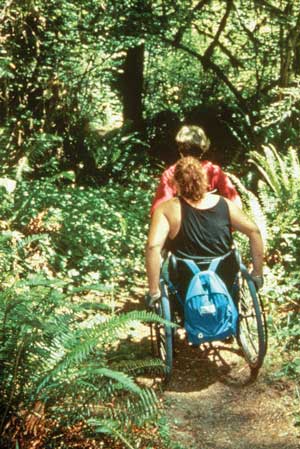What Terminology Should Be Used?
Although people who have disabilities refer to themselves in many different ways and numerous "buzz words" have been used to describe people with disabilities over the years, direction for terminology was provided in the early 1990s. The 1990 Americans with Disabilities Act (ADA) uses the phrase persons with disabilities and the word accessible. When Section 504 of the Rehabilitation Act of 1973 was renewed and amended in 1992, its terminology was corrected to include accessible and persons with disabilities. Federal agency regulations, policies, and documents have used terminology that matches ADA and the Rehabilitation Act since that time.
A disability is a medically definable condition that causes a limitation in one or more of a person's major life activities, such as walking, seeing, hearing, speaking, breathing, thinking, and so forth. Person-first terminology is used because the person is more important than his or her disability. Examples include:
-
A person who is blind—not "a blind person"
-
A person who uses a wheelchair—not "a wheelchairbound person" or "a wheelchair person"
A handicap is a barrier or circumstance that makes progress difficult, such as a flight of stairs that may be impassable for a person using a wheelchair or a negative attitude toward a person who has a disability. The word "handicapped" has negative connotations and has been around for centuries, though it wasn't used to refer to people with disabilities until the late 1800s. Many people believe that "handicapped" was first used in relation to persons with disabilities when Civil War veterans (with injuries that prevented them from working) were begging on the streets with "cap in hand." Standard references do not support this story. But because the story has become legend and begging for a living is degrading, describing people with disabilities as "handicapped" is offensive to most people with disabilities. The word "handicapped" should be eliminated from vocabulary, publications, and other materials.
Disability Etiquette
-
Use common sense and extend common courtesy to everyone.
-
Don't patronize anyone; treat adults like adults.
-
Be patient. Some people need more time to express themselves or move about.
-
Relax and be yourself. It's okay to use common phrases such as "see you later" when talking with a person who is blind or has limited vision.
-
Speak directly to the person and maintain eye contact, don't speak through a companion or interpreter.
-
Use person-first terminology. Don't use words like handicapped, victim, or afflicted to describe a person who has a disability.
-
Offer assistance to persons with disabilities, wait for their response, and follow their specific directions.
-
Do not pet, feed, or distract service animals without first asking permission. They are working animals, not pets.
Accessible facilities comply with the accessibility guidelines and standards. A site, facility, or program is either accessible or it is not accessible. For instance, figure 2 illustrates one type of trail that complies with accessibility guidelines. The only way to evaluate accessibility is to evaluate the facility's compliance with the guidelines in effect at the time it was designed, constructed, or altered. There are no shades of accessibility. For instance, a parking space complies with the standards and is accessible, or it doesn't comply with the standards and is not accessible. The specific technical requirements of the standards for surfacing, slope, and the size of the parking space and walkway connection must be met, regardless of the conditions around the parking space.

Figure 2—Two friends enjoy a trail that complies with the guidelines and allows them to hike through the rain forest.
Other phrases concerning accessibility that are not correct include: partially accessible, accessible with assistance, barrier free, ADA accessible, and handicapped accessible. A facility is either accessible or it is not accessible. If the facility is not accessible, the visitor or employee needs to know which specific areas are not accessible. "Partially accessible" and "accessible with assistance" imply some accessibility problems, but don't provide enough information to be helpful. "Barrier free" isn't legally defined or commonly understood. "ADA accessible" confuses laws with accessibility standards. "Handicapped accessible" is a common phrase, but it is offensive to many people with disabilities and should not be used. "Handicapped accessible" is also a contradiction because a handicap is a barrier and accessible means there aren't any barriers. The best terminology is simply accessible and not accessible.

User Comments/Questions
Add Comment/Question